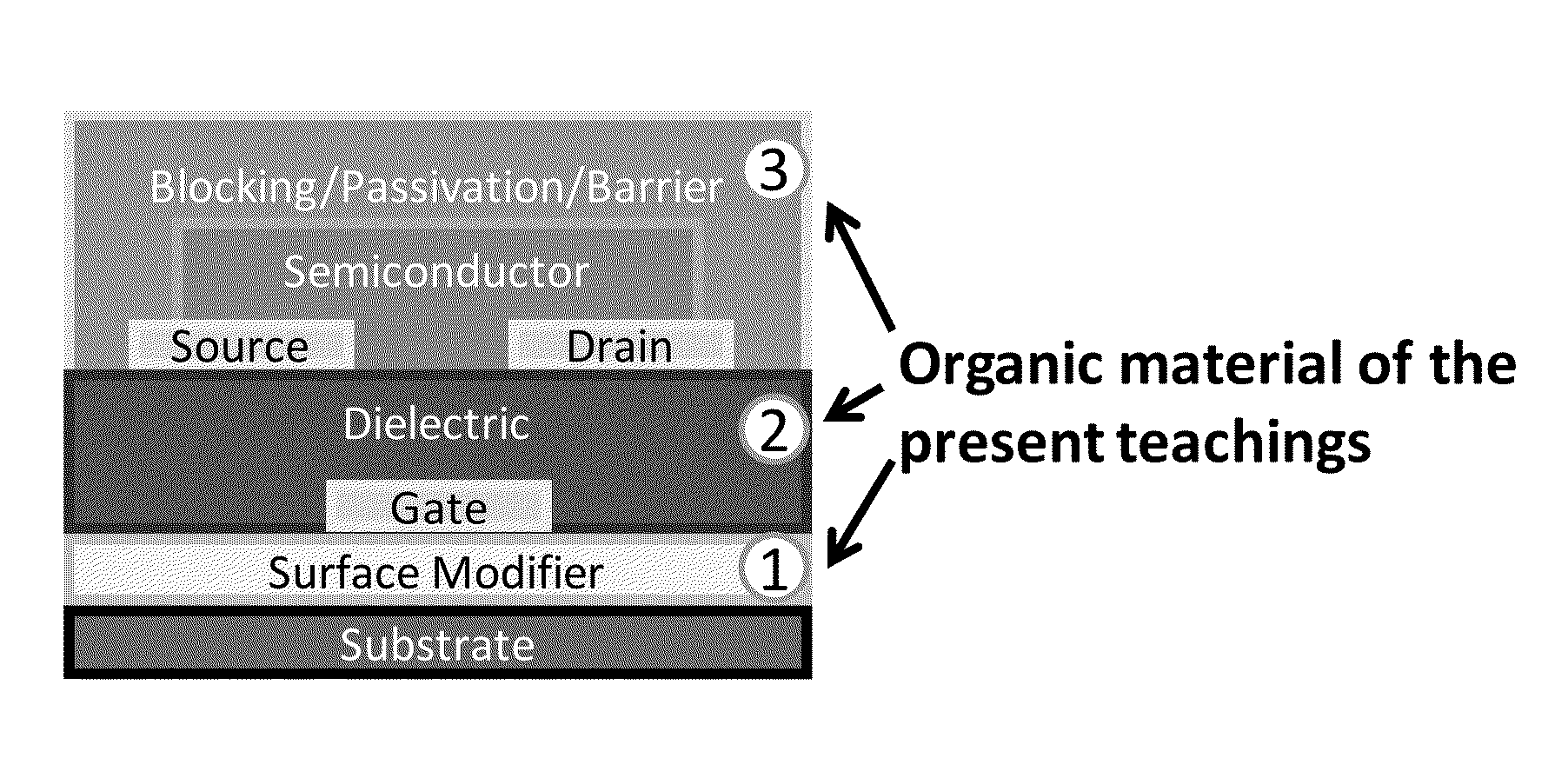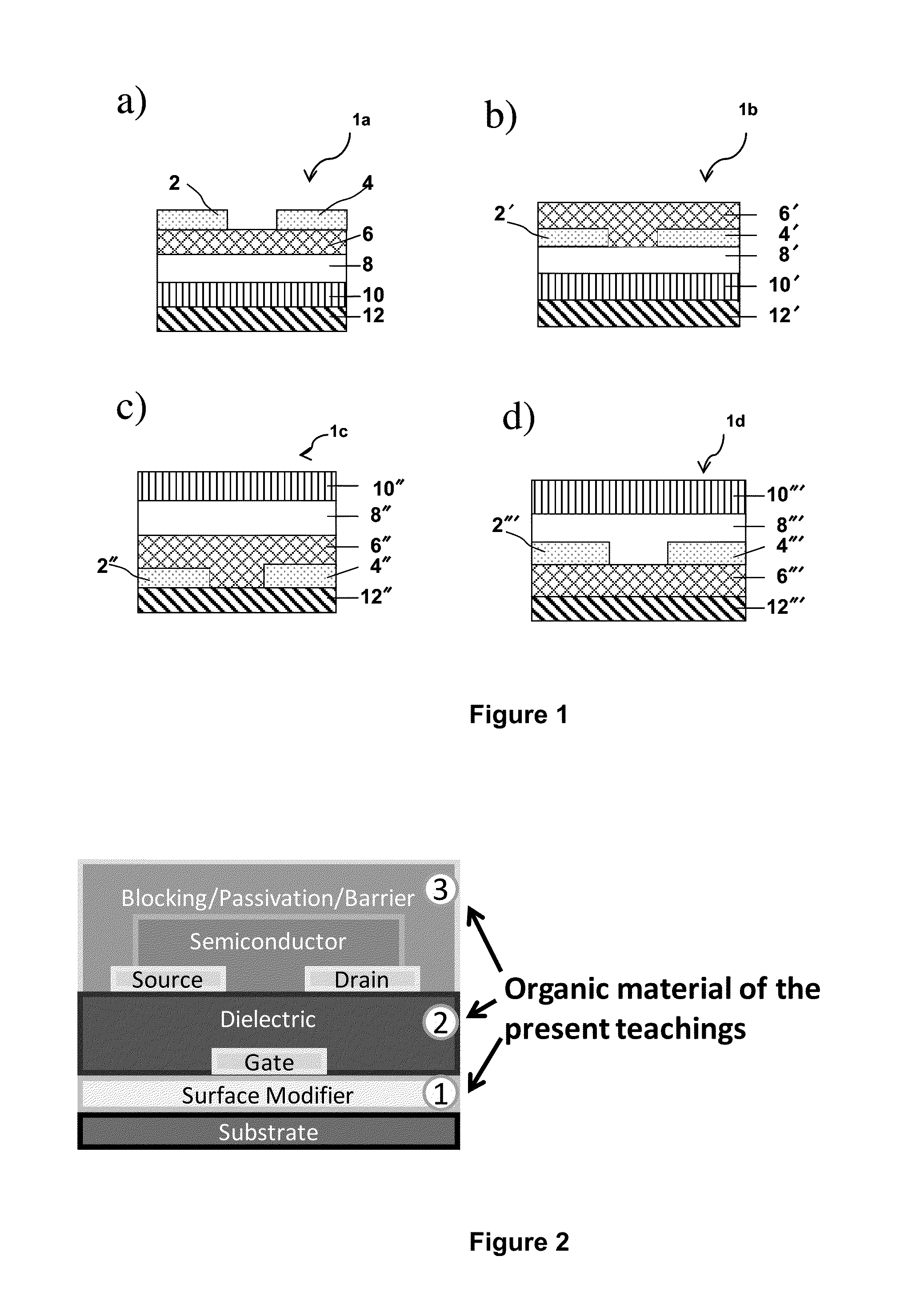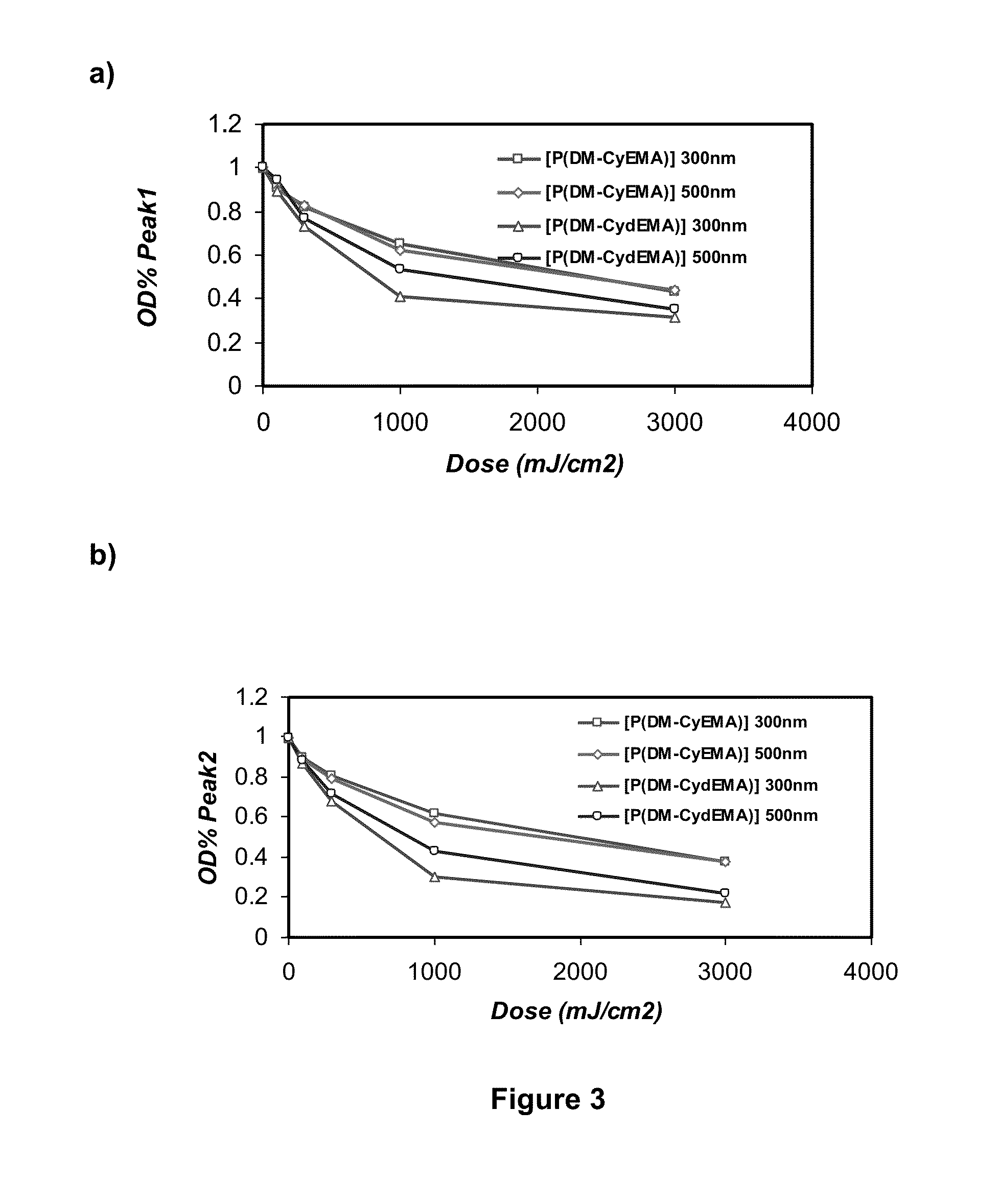Photocurable Polymeric Materials and Related Electronic Devices
a technology of polymeric materials and electronic devices, applied in thermoelectric devices, photomechanical devices, instruments, etc., can solve the problems of limiting the thickness of the layer, the effect of reducing the electrical breakdown strength and high electrical breakdown strength
- Summary
- Abstract
- Description
- Claims
- Application Information
AI Technical Summary
Benefits of technology
Problems solved by technology
Method used
Image
Examples
example 1
Polymer Synthesis
Example 1a
Synthesis of P(DM-CydEMA)
[0115]
Step 1: Preparation of 2 (ethyl dimethoxy-cinnamylideneacetate)
[0116]To a suspension of NaH (60% dispersion in mineral oil, 1.39 g, 34.75 mmol) in 30 mL of anhydrous DMF was slowly added a solution of triethyl 4-phosphonocrotonate (7.7 mL, 34.75 mmol) in anhydrous DMF (20 mL). The resulting mixture was stirred at room temperature for 30 min under nitrogen and then a solution of 1 (2,5-dimethoxybenzaldehyde) (5.25 g, 31.59 mmol) in 20 mL of anhydrous DMF was added. The reaction mixture was stirred at room temperature for 15 h and then quenched with water. Ethyl acetate was added and the organic phase was separated, dried over Na2SO4, concentrated on the rotary evaporator to yield the crude compound as a yellow oil. The crude was purified by column chromatography (silica gel, hexanes:ethyl acetate (4:1, v / v)) to give compound 2 (ethyl dimethoxy-cinnamylideneacetate) as a bright yellow solid (6.23 g, 75.1% yield).
[0117]1H NMR (5...
example 1b
Synthesis of P(DM-Cyd / Acetyl(0.8:0.2)EMA)
[0124]
[0125]Poly(hydroxyethyl methacrylate) (1.0 g, Mw=20,000 g / mol, hydroxy group: 7.68 mmol) was dissolved in 5.0 mL of anhydrous pyridine. A solution of 4 (dimethoxy-cinnamylideneacetyl chloride) (1.55 g, 6.14 mmol, 0.8 equiv.) in 10.0 mL of anhydrous THF was slowly added to this polymer solution. The reaction mixture was stirred at room temperature overnight, and then a solution of acetyl chloride (0.3 g, 3.84 mmol, 0.5 equiv.) in THF was added, and the reaction was stirred for an additional 10 h. The reaction mixture was precipitated into ˜100 mL of ice-cooled methanol (MeOH). The polymer precipitates were collected and purified by two additional dissolution-precipitation steps (THF / MeOH) to yield poly(dimethoxy-cinnamylideneacetyl / acetyl(0.8:0.2)ethylmethacrylate) P(DM-Cyd / Acetyl(0.8:0.2)EMA) as a yellow solid.
example 1c
Synthesis of P(CydEMA)
[0126]
Step 1: Preparation of 6 (cinnamylideneacetyl chloride)
[0127]Compound 5 (cinnamylideneacetic acid) (5.0 g, 28.7 mmol) was dissolved in 90.0 mL of anhydrous THF, and treated with oxalyl chloride (3.0 mL, 34.3 mmol) and 3 drops of DMF. The reaction mixture was stirred at room temperature for 4 h and then concentrated on a rotary evaporator to remove all the volatiles. Compound 6 (cinnamylideneacetyl chloride) was obtained as a pale yellow solid (5.0 g, 90.4% yield).
[0128]1H NMR (500 MHz, CDCl3): δ 7.65 (dd, 1H, J=7.5 Hz, 11.5 Hz), 7.54 (d, 1H, J=2.0 Hz), 7.53 (d, 1H, J=2.0 Hz), 7.44 (m, 3H), 7.11 (d, 1H, J=15.0 Hz), 6.95 (dd, 1H, J=7.5 Hz, 11.5 Hz), 6.21 (d, 1H, J=12.5 Hz).
Step 2: Preparation of poly(cinnamylideneacetylethylmethacrylate) [P(CydEMA)]
[0129]Poly(hydroxyethyl methacrylate) (1.56 g, Mw=20,000 g / mol, hydroxy group: 11.99 mmol) was dissolved in 5.0 mL of anhydrous pyridine. A solution of 6 (cinnamylideneacetyl chloride) (3.0 g, 15.57 mmol) in 10.0...
PUM
| Property | Measurement | Unit |
|---|---|---|
| solubility | aaaaa | aaaaa |
| solubility | aaaaa | aaaaa |
| solubility | aaaaa | aaaaa |
Abstract
Description
Claims
Application Information
 Login to View More
Login to View More - R&D
- Intellectual Property
- Life Sciences
- Materials
- Tech Scout
- Unparalleled Data Quality
- Higher Quality Content
- 60% Fewer Hallucinations
Browse by: Latest US Patents, China's latest patents, Technical Efficacy Thesaurus, Application Domain, Technology Topic, Popular Technical Reports.
© 2025 PatSnap. All rights reserved.Legal|Privacy policy|Modern Slavery Act Transparency Statement|Sitemap|About US| Contact US: help@patsnap.com



